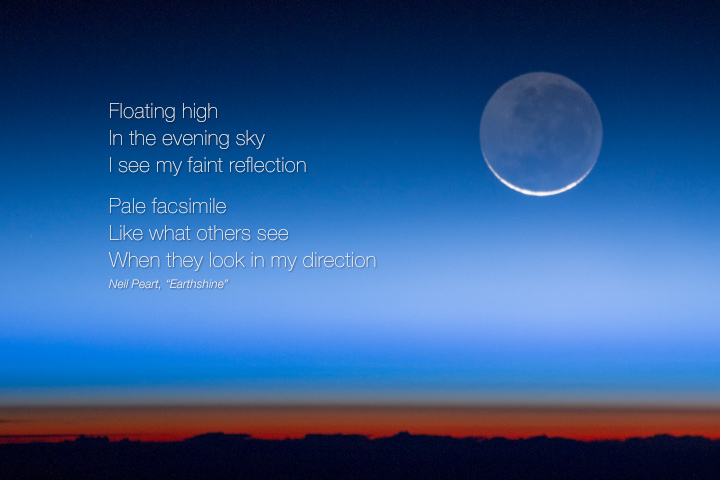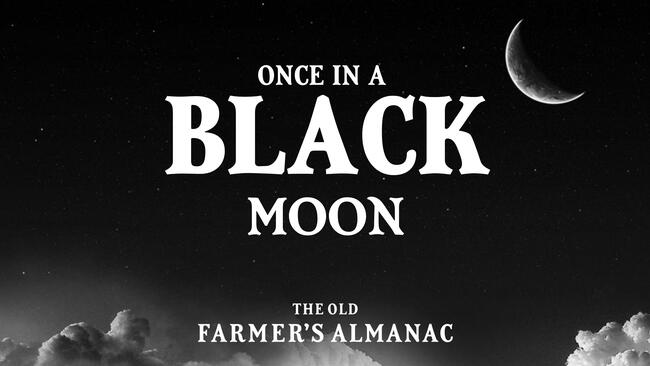Ever noticed that you can sometimes see the part of the Moon that isn’t lit up? The dark portion of the Moon (the area unlit by the Sun) seems to glow. This phenomenon is known as “Earthshine.” Historically, this was called “the new Moon in the old Moon’s arms.” Learn more about Earthshine.
What is Earthshine?
When you can see the dark, unlit portion of the crescent Moon (the area unlit by the Sun), that’s actually sunlight that’s been reflected off of Earth, then bounced off the Moon and back to our eyes! It gives the dark, unlit portion of the Moon an eerie radiance.
This is unique in all the universe: Only the Moon is near enough to reflect back our own light for our narcissistic enjoyment.
What Causes Earthshine?
This occurs because 38 percent of the sunlight that strikes Earth bounces back into space; some of this earthlight bathes the lunar surface. About 10 percent of that light bounces off the lunar surface (which is not very reflective) to create the visible glow (Earthshine) on the Moon’s dark side.
The thinnest Moon crescents (both waxing and waning) display the brightest Earthshine. This is due to the phase reciprocity of the Earth and the Moon: When the Moon appears thinnest from Earth, Earth would look full from the Moon. Conversely, Earth would appear to be unlit, or in its “new” phase, if viewed from the Moon during what we would see as the Moon’s full phase.
Don’t be fooled: The portion of the crescent Moon that is illuminated by Earthshine appears to be part of a smaller orb than the sunlit crescent. This mirage is caused by our eyes’ response to the different light levels. It vanishes when you view the crescent through binoculars.

During what Moon phases does Earthshine occur?
Earthshine is most apparent in the few days before and after a New Moon, when you’ll see a thin crescent Moon in the night sky. See the Moon Phase Calendar!
To astronomers and scientists, “new Moon” means “no Moon.” The phase describes the date and hour when the Moon is closest to the Sun and completely obscured from Earth by solar glare. Two days earlier or two days later, when the Moon is not in line with the Sun and therefore only marginally in view, the slender waxing crescent appears just above the western horizon.
Only when the Moon is a thin crescent does its sunless portion receive the brilliance of a virtual full Earth. This is partly because there’s less of the bright, sunlit surface to compete with the dimmer Earthshine-lit portion, and partly because the phases of Earth and the Moon are complementary: when the Moon is a slim crescent in our sky, Earth seen from the Moon looks nearly full.
The best time of the day to see Earthshine is in the evening following sunset—or, view before dawn. And the best time of the year to experience this phenomenon is in late winter and early spring.
Cool Earthshine Facts
- The phases of Earth and Moon are complementary. When the Moon is a skinny crescent, lunar colonists would see Earth in their sky as nearly full. Conversely, when the Moon is full, then our world is “new” in the Moon’s sky, and they only see our night hemisphere.
- As a result of all of the sun- and Earthshine bouncing, the crescent Moon’s earthlight is older than its sunlight.
- If the Sun were to go dark suddenly, the crescent Moon would disappear at the same time, but Earthshine would continue to illuminate the Moon faintly for 3 seconds.
The Old Moon in the New Moon’s Arms
In the olden days, Earthshine was called “the old Moon in the new Moon’s arms.” You’ll also hear it as “the new Moon in the old Moon’s arms.” Earthshine is sunlight that’s taken a detour. Sunshine hits us, bounces to the Moon, then bounces back to our eyes to enable us to see it. It’s a three-way trip, making the glow on the Moon’s dark side “older” than the direct sunlight illuminating the brightly lit crescent.
That’s why, if the Sun were to blow up, the bright crescent would vanish first, but the dimmer Earthshine would linger for an additional 3 seconds—light’s round-trip time from Earth to the moon. If you see this happen, grab the phone and sell your stocks. This knowledge will give you a few seconds’ head start over everyone else.











Comments